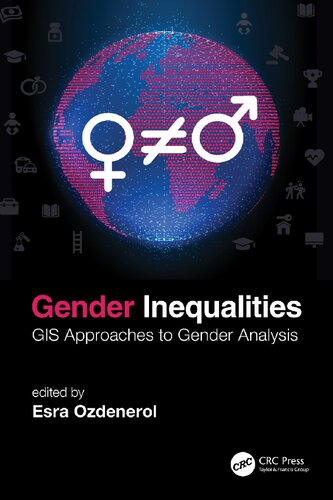Product desciption
Gender Inequalities Gis Approaches To Gender Analysis Esra Ozdenerol by Esra Ozdenerol 9780367184735, 9780429196584, 0367184737, 042919658X instant download after payment.
Gender inequality is entrenched in the cultural, political, and market systems that operate at household, community, and national levels. Overarching global changes in access to markets, climatic conditions, and the availability of natural resources intensify disparities in income, assets, and power among genders. This book explains these gender dynamics at macro and micro levels through GIS and spatial analysis. Chapter 1 provides an overview of the current role of GIS in the context of gender inequalities, how it still exists globally despite substantial national and international measures that have been taken toward gender equality. It illustrates global and country-level maps of measures of gender inequalities, such as gender equality index, access to basic education, health and life expectancy, equality of economic opportunity, and political empowerment. The global case studies provided in the consequent chapters explore the world of gender inequalities and get directly involved with some of the GIS and mapping applications. Chapter 2 investigates how GIS can be adapted for the criminal justice response to domestic violence (DV) and to eliminate gender-based violence. Chapter 3 discusses applying GIS and spatial analysis to the prevalence and incidence mapping of intimate partner violence (IPV) and geospatial factors that influence help-seeking and resource availability. Chapter 4 discusses the spatial disparity of gender-representation across industry types in the United States. Chapter 5 explores the social and environmental injustice experienced by female migrant workers at Guiyu town, China, in the context of both environmental pollution and governance. Chapter 6 presents a social vulnerability index to identify spatial patterns of social vulnerability and gender inequalities among Mexican households. Chapter 7 presents the United States’ opioid crisis over the past two decades and analysis of mortality by gender, race, age, and urbanicity. Chapter 8 discusses the commitment to "leave no one behind" as the heart of the 2030 Agenda for Sustainable Development and identifies inequalities among women and girls by mapping multiple deprivations in Pakistan. Chapter 9 discusses the long-standing challenges in establishing gender parity in the transportation workforce in the United States. Chapter 10 presents a study that utilizes geospatial statistical tools and state-level admission data to examine gender inequalities in higher-education enrollment in Nigeria and investigates the key factors on enrollment.
This book fosters engagement with the newest mapping and GIS application in contemporary issues regarding gender inequalities and nurtures recognition of how institutional global, everyday, and intimate spaces are inherently gendered, classed, raced, and sexualized. It demonstrates the spatiality of the politics of gender difference, and the contributions of GIS and spatial analysis to the struggles for equality and social justice.
A unique work that
Lays out a step-by-step approach to identify relevant GIS applications, spatial methods, data collection, and mapping techniques for gender inequalities research
Has a strong international and global perspective. The author is well-informed in global perspectives
Investigates the patterns/processes and indicators driving gender inequality at various temporal scales and at comparably detailed resolutions
Illustrates finer-scale case studies, appropriate for local programs and interventions, as well as global scale studies contributing to international and national-level policy discussions on gender inequality
Since gender inequality is a research area that is very wide and with strands into many academic traditions, this book is aimed at different and diverse academics/research. It is written for geographers, public health practitioners, sociologists, epidemiologists, criminologists, politicians, economists, environmentalists, GIScientists, and health and research professionals interested in applying GIS and spatial analysis to the study of gender inequalities.


